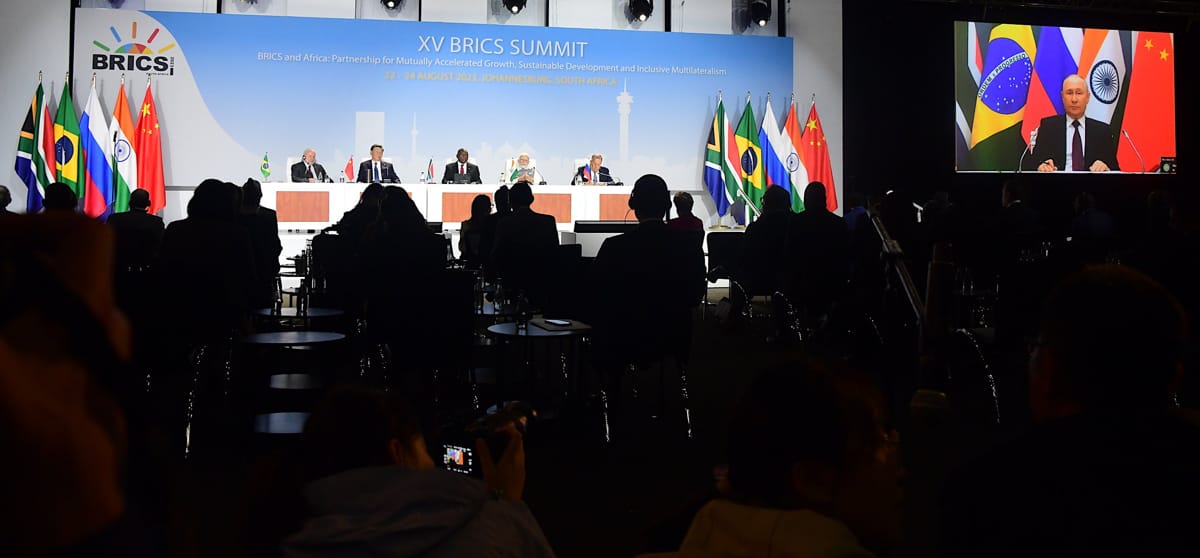Russian President Vladimir Putin will host the 25th BRICS summit in the Russian city of Kazan on 22–24 October.
It comes at a time when BRICS – comprising Brazil, Russia, India, China, and subsequently South Africa – faces an inflection point.
Emerging out of the 2007–09 global financial crisis as a group of major emerging economies, having been first dubbed by Goldman Sachs as major markets, the avowed objective of BRICS was to reform global financial architecture, seeking to make international financial institutions, especially the World Bank and International Monetary Fund, more representative, boosting the influence of developing countries, and lessening perceived Western dominance.
On paper, certainly, BRICS is a heavy hitter. It has size and weight, accounting for nearly 30 per cent of global GDP (even more, expressed in purchasing power parity terms) and 45 per cent of the world’s population. This masks, though, real asymmetries: China is responsible for nearly 70 per cent of BRICS’ economic output.
The ambition to reform global financial governance to reflect greater multipolarity remains a common denominator uniting BRICS members. They promote increased use of national currencies in their trade, reducing dependence on the US dollar, and seek an alternative global payments system, bypassing the SWIFT network. This particularly appeals to Russia, keen to obviate Western sanctions.
But it’s increasingly clear that BRICS members have divergent, and competing, objectives and visions for its future.
Substantive progress in key areas is proving slower and harder.
China and Russia see BRICS in more adversarial geopolitical terms, beyond its global governance reform aspirations. They see BRICS as offering a counterweight to the G7, challenging the US-led rules-based order. Its emergence reflects the “transformation of global governance architecture and world order” and moves towards a “redistribution of power in the world”.
For Beijing, BRICS is a vehicle for advancing its leadership ambitions, and promoting its economic interests, in the Global South. While for Moscow, estranged from the West by its 2022 invasion of Ukraine, and beset by sanctions, BRICS provides coveted international legitimacy and connections.
On the other hand, India and Brazil remain focused on BRICS primarily as a means of advancing reform of the international order to reflect genuine multipolarity and give large developing countries greater influence.

India and Brazil are suspicious of China’s aim to instrumentalise BRICS to entrench its power and influence in the Global South. And they are unhappy at Moscow’s push to give BRICS a more sharply anti-American character; New Delhi and Brasilia are anxious to preserve their relationships with the United States and other Western partners. They don’t want BRICS to become a vehicle for confrontation with the West, but see it instead as a way for the Global South to navigate between China–US rivalry.
These divergent views and interests are apparent on the practical issue of membership expansion.
China is the driver of expansion, as Beijing would likely dominate the enlarged grouping by dint of its economic weight and influence. Moscow too supports enlargement, as symbolising growing global rejection of US primacy and the failure of Western efforts to isolate Moscow internationally.
Russia will no doubt trumpet the outcomes of the upcoming Kazan summit as further consolidation of BRICS as a major player on the international stage.
But, for the same reasons, India and Brazil are cautious about expansion: having more members will complicate decision-making, making it harder to reach consensus; expansion risks skewing BRICS’ orientation in a more markedly anti-Western way; and, importantly, it risks diluting the influence of New Delhi and Brasilia within BRICS.
At last year’s BRICS summit in Johannesburg, China and Russia appeared to win out, when leaders invited six new members to join: Egypt, the UAE, Iran, Saudi Arabia, Ethiopia and Argentina (although the latter subsequently declined to join, after President Javier Milei’s election). Saudi Arabia’s membership status also remains unclear: while participating in BRICS meetings, Riyadh hasn’t yet formally responded to the invitation to join.
In what smacks of an internal compromise, BRICS foreign ministers agreed in June that the grouping would take a pause on further expansion, and first establish criteria for “partnership” as a stepping stone to full membership. Yet this is unlikely to dampen Beijing and Moscow’s enthusiasm for continued BRICS expansion; and Türkiye, for one, seems keen to join.
Russia will no doubt trumpet the outcomes of the upcoming Kazan summit as further consolidation of BRICS as a major player on the international stage. And as current chair, Moscow is assiduously promoting sectoral mechanisms for cooperation among BRICS members across the gamut of political, economic and cultural affairs, giving the appearance of an energised and effective organisation.
There is an element of pokazuka (show) in this frenzy of activity. Substantive progress in key areas is proving slower and harder. The use of national currencies in trade between BRICS states (dominated anyway by bilateral trade flows between China and other members) is growing, but still has some way to go.
It would be a mistake to under-estimate the potential importance of BRICS as a global force. But just how significant and effective it will become is still moot.
Success will require BRICS to manage the differing national interests, priorities and outlooks of its member states in order to carve out a distinctive niche and forge coherent approaches that unite its members on major international issues. Conversely, though, if unresolved, the divergent interests and views of its members, notably China and India, will undermine BRICS’ cohesion and limit its effectiveness.

